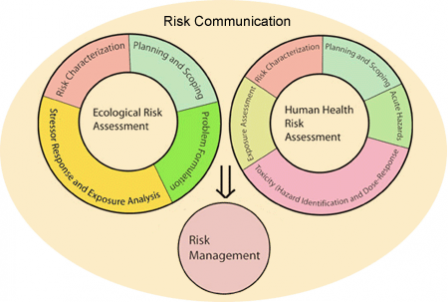Superfund Risk Assessment
While intended primarily as a resource to EPA, State, other federal agency and contractor risk assessors and toxicologists, the Superfund risk assessment pages provide guidance, tools and databases useful for preparing human health and ecological risk assessments on the types of hazardous waste sites addressed by EPA land cleanup programs. The Superfund risk assessment content may also help citizens and risk managers better understand Superfund's risk assessment process.
On this page:
- Basic risk assessment information and guidance
- Superfund risk assessment paradigm
- EPA's Ecological Risk Assessment Support Center
Basic Superfund risk assessment information and guidance
Superfund risk assessments determine how threatening a hazardous waste site is to human health and the environment. Risk Assessors seek to determine a safe level for each potentially dangerous contaminant present.
For humans, this is a level at which ill health effects are unlikely and the probability of cancer is very small. The Risk Assessment Guidance for Superfund (RAGS) should be followed when assessing human health risks at Superfund sites.
For ecological receptors, determining the level of risk is more complicated and is a function of the receptors of concern, the nature of the adverse effects caused by the contaminants, and the desired condition of the ecological resources. The Ecological Risk Assessment Guidance should be followed when assessing ecological risks at Superfund sites.
EPA conducts site-by-site risk assessments to address the unique contaminants and range of potential health effects at Superfund sites. Conducting risk assessments produce estimates of current and possible future risks, if no cleanup actions were taken. Superfund's risk managers use risk assessment information and other site factors to select the best cleanup strategies to manage risks to acceptable levels.
Superfund risk assessment paradigm
 Risk Communication Diagram
Risk Communication Diagram
The diagram represents the components of ecological and human health risk assessments in the Superfund and Resource Conservation and Recovery Act (RCRA) programs. Risk Assessments may proceed in a straightforward, linear fashion, but often repeat stages depending on sampling and analytical results and on decisions made by risk assessors and risk managers.
EPA's Ecological Risk Assessment Support Center (ERASC)
ERASC provides technical information and addresses ecological risk assessment scientific questions at hazardous waste sites. They provide this assistance to EPA's Office of Solid Waste and Emergency Response (OSWER) personnel and to regional Superfund and RCRA staff. Requests must be channeled to ERASC through the Ecological Risk Assessment Forum (ERAF). To assess emerging and complex scientific issues that require expert judgment, the ERASC relies on the expertise of scientists and engineers located throughout EPA Office of Research and Development (ORD) labs and centers. ERASC develops responses that reflect the "state of the science" for ecological risk assessment and also provides a communication point for the distribution of the responses to other interested parties.
For further information, contact Erasc.Ecology@epa.gov or call 513-569-7940 or visit ERASC's website at http://www.epa.gov/erasc
